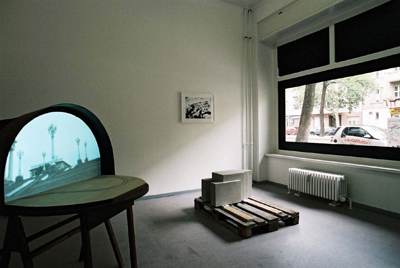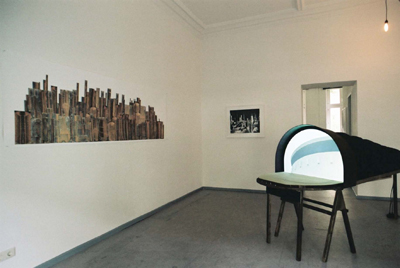Romana Schmalisch – Drehort Zukunft
*** English version below ***
Eröffnung Freitag, 30. Mai 2008, 19 Uhr
Laufzeit 31. Mai – 19. Juli 2008
Drehort Zukunft ist der zweite Teil von uqbars Ausstellungsreihe zu Raumkonzepten und zeitgenössischer Architektur. In der Ausstellung untersucht die Künstlerin Romana Schmalisch (*1974 in Berlin, lebt und arbeitet in Berlin) modellhaft Visionen und Entwicklungen von Stadtbildern. Zentrale Referenzpunkte sind dabei die sowjetische Geschichte sowie der sowjetische Film des frühen 20. Jahrhunderts, der parallel zur Proklamation einer neuen Gesellschaft die Visionen und Utopien einer neuen Stadt in Szene setzte. Durch eine komplexe Montage von Zitaten und Versatzstücken aus historischen Spielfilmen, Filmrequisiten, aktuellen Stadtaufnahmen und Modellen durchleuchtet die Künstlerin das mediale Bild der Stadt.
Ein zentrales Element der Ausstellung ist die Rekonstruktion eines Filmrequisit aus Alexander Medwedkins Spielfilm Das neue Moskau (Novaya Moskva, 1938), ein Projektions- und Vorführtisch, der zwischen Stadtmodell, Kino und Plattenkamera changiert. Der zitierte Film handelt von einem Ingenieur, der aus Sibirien nach Moskau reist und mithilfe des mobilen Experimentiermodells seinen Entwurf für das neue Moskau vorstellt, für jene Stadt, die er nie gesehen, aber immer schon erträumt hat. Zunächst zeigt er Dokumentaraufnahmen von der Sprengung alter Gebäude, um an deren Stelle dann die neue Stadt in Zeichnungen und Modellen erscheinen zu lassen. Die Künstlerin verwendet das nachgebaute Objekt zur Projektion ihres Films Decision of the Party (2008), der aktuelle Super-8Aufnahmen der Stadt Wolgograd mit einer Tonspur aus dem propagandistischen Spielfilm Der Schwur (Kljatwa, 1946) kombiniert. In diesem Film lässt Josef Stalin „seine“ Stadt Stalingrad, heute Wolgograd, planen und realisieren. So trifft die heutige reale Stadt auf die mediale Vision von damals und wird innerhalb des Films wieder zur Projektion der damaligen Geschichte.
Die Betonskulptur Vorspann setzt einen weiteren Bezug zum Film. Das Modell ist eine im Maßstab 1:20 verkleinerte Rekonstruktion des Sockels der Stahlskulptur Arbeiter und Kolchosebäuerin, die mit ihren Figuren zum Symbol des sowjetischen Films wurde, da sie – wie der „brüllende Löwe“ bei Metro-Goldwyn-Mayer – als Erkennungszeichen den Vorspann der Produktionen der Mosfilm-Gesellschaft zierte. Die Skulptur wurde von der russischen Bildhauerin Vera Muchina ursprünglich für den Pavillon der UdSSR auf der Pariser Weltausstellung 1937 entworfen. Später stand sie lange Zeit an einem zentralen Platz in Moskau, bis sie vor einigen Jahren in einem Archiv verschwand und lediglich den leeren Sockel zurückließ.
Diese zwei raumgreifenden Objekte werden von zwei Siebdrucken flankiert, die weitere filmische Stadtbilder zeigen, in denen sich gesellschaftliche Umbruchsituationen kristallisieren. Die Vorlagen für Arbeiterquartier und Soazera sind Standbilder, die Sergej Eisensteins Film Streik (Statschka, 1924) bzw. Jakow Protasanows Aelita (1924) entnommen sind.
Mit Drehort Zukunft führt Romana Schmalisch ihren Arbeitszyklus Reconstructing Futures weiter, in dem sie in Installationen, Filmen und Performances gesellschaftliche Utopien und deren Brüche untersucht. Eine erste Präsentation fand 2007 im Wilhelm Lehmbruck Museum Duisburg statt, das die Installation Future Cities (2007) für seine Sammlung erwarb.
Opening Friday, May 30, 2008, 7 p.m.
Duration May 31 – July 19, 2008
Drehort Zukunft represents the second of a series of exhibitions on spatial concepts and contemporary architecture taking place at uqbar project space. In the current exhibition, the artist Romana Schmalisch (born in Berlin in 1974, lives and works in Berlin) analyses in a modellike setup visions and developments of the image of the city. Central references for her are the Soviet history and the Soviet cinema of the early 20th century, which depicted visions and utopias of a new city in accompaniment to the proclamation of a new society. In a complex montage of quotations and elements from historical movies, film properties and current city photographs and models, the artist investigates the medial representation of the city.
The reconstruction of a property from Alexander Medvedkin’s film The New Moscow (Novaya Moskva, 1938) takes a central place in the exhibition: a projection table oscillating between a city model, a cinema and a plate camera. In the cited movie, an engineer travels from Siberia to Moscow to present by means of this mobile experimentation model his plans for the new city, a city he has never seen but always dreamt of. At first, he shows documentary shots of old buildings being demolished, whose place is then taken by the new city presented in drawings and models. The artist now uses this recreated object to project her film Decision of the Party (2008), which combines Super8 material from today’s Volgograd with parts of the sound track from the Soviet propaganda film The Promise (Kliatva, 1946). In this movie, Joseph Stalin plans and realises “his” city, Stalingrad (now Volgograd). Thus, the real city of today is juxtaposed with its past medial vision, in turn becoming a projection of its own history within the film.
The concrete sculpture Vorspann (Credits) is another reference to Soviet cinema. This model is a reduced reconstruction (1:20) of the pedestal for the steel sculpture The Worker and the Peasant Woman, which became a symbol of Soviet movie production, as it appeared – akin to Metro-Goldwyn-Meyer’s “roaring lion” – during the credits of all films by the Mosfilm company. The sculptress Vera Mukhina had originally created this sculpture for the Soviet Pavilion at the Paris World Fair in 1937. Afterwards, it stood at a central square in Moscow for a long time to eventually disappear in the archives some years ago, only leaving its vacant pedestal.
These two spatial objects are accompanied by two serigraphs showing further cinematographic images of the city as crystallisations of situations of social upheaval. Arbeiterquartier (Working-Class District) and Soazera use still images from Sergei Eisenstein’s movie Strike (Statshka, 1924) and Yakov Protazanov’s Aelita (1924) respectively.
Drehort Zukunft continues Romana Schmalisch’s work cycle Reconstructing Futures, in which she analyses social utopias and their ruptures in installations, films and performances. A first presentation of these works took place at the Wilhelm Lehmbruck Museum Duisburg, which acquired the installation Future Cities (2007) for its collection.



